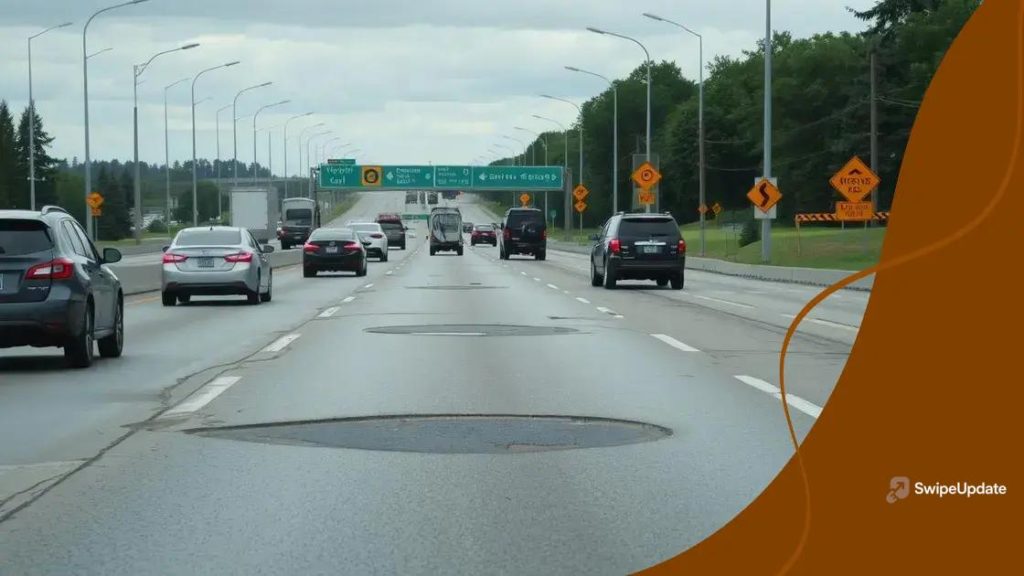The current condition of infrastructure in the United States

The current condition of infrastructure in the United States is marked by aging structures, inadequate funding, and increasing demands, emphasizing the need for sustainable investments and innovative solutions to improve safety and efficiency.
The current condition of infrastructure in the United States is a pressing issue that affects everyone in the country. Have you noticed potholes on your commute or delays in public transport? These everyday experiences often reflect deeper problems in our infrastructure, and understanding them is essential for a safer future.
Overview of the current infrastructure landscape
The current infrastructure landscape in the United States is quite complex. It involves roads, bridges, airports, and rail systems, all of which are essential for daily activities. Understanding this intricate web of infrastructure helps us appreciate its role in our lives.
Key Components of Infrastructure
There are several major components that form the backbone of our infrastructure:
- Transportation networks: Highways, railways, and airports that connect cities and support commerce.
- Utilities: Water supply, electricity, and gas systems that ensure our homes and businesses function smoothly.
- Buildings: Schools, hospitals, and other essential facilities that serve public needs.
Each element plays a crucial role in the overall effectiveness of our infrastructure. The condition of these components varies greatly across regions, causing disparities in access and quality. For instance, some areas enjoy modern highways, while others struggle with crumbling roads.
Current Challenges
But what challenges are present today? Aging infrastructure poses a significant problem. Many structures are decades old and require urgent repairs. Additionally, funding for infrastructure projects is often limited, leading to delays in necessary upgrades.
These issues raise important questions about safety and effectiveness. Can we rely on our roads and bridges to support the growing number of vehicles and commercial transportation? As urban populations grow, the demand on infrastructure continues to rise, which further complicates the situation.
Indeed, a significant factor in the infrastructure debate is funding. Government budget constraints often make it difficult to tackle all the needed repairs at once. As a result, prioritizing which projects to address first becomes essential to ensure that critical areas receive attention.
Conclusion
In the end, being aware of the current infrastructure landscape empowers us as citizens. Understanding the challenges helps generate discussions about necessary changes. As we look forward, improving infrastructure should remain a priority for everyone’s safety and benefit.
Key challenges facing U.S. infrastructure
The key challenges facing U.S. infrastructure are multifaceted and impact daily life. As our population grows and technology advances, existing infrastructure struggles to keep pace. Understanding these challenges is important for finding solutions.
Aging Structures
One of the most significant issues is the aging of critical infrastructure. Many roads, bridges, and tunnels were built decades ago and need repairs or replacement.
- Approximately 40% of roads are in poor or mediocre condition.
- Bridges are often rated as structurally deficient.
- Maintenance backlog leads to higher costs in the long run.
This means that safety is a growing concern, as weakened structures pose risks to users. Addressing these aging components should be a top priority for communities.
Funding Limitations
Another challenge is the lack of adequate funding. Many infrastructure projects require substantial financial investment, but local and federal budgets often fall short. This leads to delays in essential upgrades.
Funding limitations impact various kinds of infrastructure, making it hard to prioritize projects. Workers in some regions may face longer commutes due to poor road conditions, while others may lack essential utilities.
Environmental Considerations
Environmental challenges add another layer of complexity. Infrastructure must adapt to changing climates, which can lead to unexpected issues like flooding or road erosion.
As we develop new systems, we must also consider sustainability. Balancing development with ecological impact is crucial for future generations. Solutions should focus not just on repairing what we have but on creating resilient systems.
Technological Integration
Lastly, integrating modern technology into existing infrastructure systems can be tricky. Innovations like smart traffic lights and advanced communication networks require careful planning and investment.
However, these technologies have the potential to improve efficiency significantly. Implementing them successfully will provide better services to the public while reducing congestion and enhancing safety.
Impact on economy and daily life

The impact on economy and daily life due to current infrastructure conditions is significant and far-reaching. Poor infrastructure can lead to increased travel times, higher transportation costs, and reduced access to essential services.
Economic Consequences
When infrastructure is not well-maintained, the economy suffers. Here are some key points to consider:
- Increased Costs: Businesses face higher shipping and transportation expenses, which can lead to increased prices for consumers.
- Lost Productivity: Traffic congestion and delays reduce worker productivity, costing the economy millions each year.
- Job Impact: Poor infrastructure can deter business investment, leading to fewer job opportunities in affected areas.
These factors create a ripple effect throughout the economy. As businesses struggle, local communities may also feel the strain, affecting services and resources available to residents.
Daily Life Effects
The everyday experience of individuals is also deeply impacted by infrastructure issues. Poor road conditions and unreliable public transport can lead to frustrations in several ways.
Imagine spending extra hours commuting due to traffic jams or worrying about the safety of bridges while driving. These inconveniences affect not just time but also emotional well-being.
Access to safe and reliable public transportation is essential for those who do not have cars. Without it, people may find it challenging to reach jobs, schools, or healthcare facilities. This can create inequalities in communities, as transportation is a key factor in accessing opportunities.
Health and Safety
Infrastructure is tied to health and safety as well. Poorly maintained roads can lead to accidents, while lack of clean water and sanitation infrastructure can impact public health.
Communities with outdated utilities may struggle with water contamination or sewage problems, leading to health crises. Addressing these infrastructure challenges is critical for ensuring the health and safety of all citizens.
Recent developments and initiatives
Recent developments and initiatives in U.S. infrastructure reflect a growing recognition of the challenges and the need for improvement. Policymakers and communities are realizing that investment in infrastructure is essential for future growth and public safety.
Federal Infrastructure Legislation
One major step was the passing of significant federal legislation aimed at upgrading infrastructure. This law focuses on various projects across the country that range from road repairs to improving broadband access.
- Funding Allocations: Billions of dollars are earmarked specifically for repairing roads, bridges, and public transit systems.
- Job Creation: These projects are expected to create numerous jobs, helping boost the economy.
- Environmental Sustainability: Many initiatives now emphasize making infrastructure more sustainable to combat climate change.
These efforts help not only to repair old systems but to create new ones that are better equipped to handle today’s demands.
Local Initiatives and Partnerships
On the local level, cities and counties are also stepping up. Collaborations between public and private sectors are increasing, allowing for innovative solutions to infrastructure needs.
For instance, some cities are exploring public-private partnerships (PPPs) to fund infrastructure projects. This method leverages private funding to relieve some financial pressure from local governments.
Technological Innovations
Additionally, technology is playing a vital role in recent developments. Smart city initiatives are gaining momentum, integrating technology into various aspects of infrastructure. This integration includes:
- Smart Traffic Systems: These systems help reduce congestion, making travel more efficient.
- Data-Driven Decision Making: Cities use data analytics to identify issues and prioritize repairs.
- Improved Communication: Enhanced communication networks support better public engagement regarding infrastructure projects.
By utilizing technology, many urban areas can create smarter, more efficient infrastructure that meets the needs of residents.
Future prospects and recommendations
The future prospects and recommendations for U.S. infrastructure are critical for ensuring that systems can meet the needs of a growing population and economy. Embracing innovative solutions and making strategic investments will be essential.
Embracing Green Infrastructure
One recommendation is to invest in green infrastructure. This approach focuses on sustainable practices that improve resilience against climate change.
- Utilizing Natural Resources: Incorporating urban trees and green roofs can help manage stormwater and improve air quality.
- Reducing Carbon Footprint: Building more energy-efficient structures can lower greenhouse gas emissions.
- Enhancing Biodiversity: Protecting ecosystems in urban planning can promote biodiversity and contribute positively to the environment.
These green initiatives not only benefit the environment but also improve the quality of life for residents.
Investment in Technology
Another important focus for future infrastructure is the integration of technology. Smart cities are becoming a priority, utilizing technology to optimize services and enhance connectivity.
Implementing smart traffic management systems can reduce congestion, while enhanced public Wi-Fi and informational kiosks can improve access to services.
This technology-driven focus will also require increased collaboration between governments, tech companies, and local communities to develop effective solutions.
Long-Term Planning and Funding
Effective long-term planning and sustainable funding models will be essential for the future of infrastructure. This includes understanding the lifecycle of infrastructure projects and maintaining them proactively.
Governments should look for diverse funding sources, including public-private partnerships and innovative financing methods. These approaches can alleviate the burden on taxpayers while ensuring essential services are funded.
Public Engagement
Lastly, involving the community in the planning process can lead to more tailored and effective infrastructure solutions. Public engagement ensures that the needs and perspectives of residents are taken into account, leading to better outcomes.
Regular town hall meetings and community workshops can foster dialogue and gather feedback, encouraging a sense of ownership among community members.
FAQ – Frequently Asked Questions about U.S. Infrastructure
What is the current state of U.S. infrastructure?
The current state of U.S. infrastructure is facing significant challenges, including aging structures and insufficient funding, leading to safety concerns and inefficiencies.
How does infrastructure impact daily life?
Infrastructure affects daily life by influencing commute times, access to services, and overall economic productivity, impacting the quality of life for citizens.
What recent initiatives have been taken to improve infrastructure?
Recent initiatives include federal legislation aimed at funding infrastructure improvements, emphasizing green practices, and integrating technology into urban planning.
Why is public engagement important in infrastructure projects?
Public engagement is crucial as it ensures that the needs and perspectives of the community are considered, leading to more effective and tailored infrastructure solutions.
